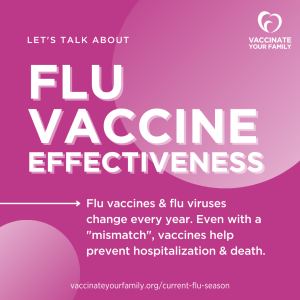Let’s Talk About Flu Vaccine Effectiveness
Editor’s Note: As of June 2022, the CDC announced new data that shows that the flu vaccine’s effectiveness this year was about 35% against infection, much higher than early estimates suggested. The very long 21-22 flu season is finally winding down. It will be important to get vaccinated against flu again this fall.
 The CDC has released data showing that the effectiveness of the flu vaccine this season was (unfortunately) low. Let’s look closer at what that means.
The CDC has released data showing that the effectiveness of the flu vaccine this season was (unfortunately) low. Let’s look closer at what that means.
The 2021-22 Flu Season By the Numbers
This flu season has been relatively mild, but flu cases did tick up this year. The U.S. has seen upwards of 4.2M illnesses, 1.9M medical visits, 49,000 hospitalizations, and 4,200 deaths including 8 children. 4,200 deaths from flu is not something we take lightly.
How Does the CDC Measure Flu Vaccine Effectiveness?
Vaccine effectiveness (VE) measures how much protection a vaccine offers against illness, hospitalization, or death (with a different VE for EACH of these). Since 2004, the CDC has estimated flu vaccine effectiveness by looking at how many people the flu vaccine keeps from getting sick enough to visit the doctor. Unfortunately, this number was lower than we’d like it to be this year.
Why? The circulating H3N2 flu strain is slightly different from the strain in this season’s vaccine, meaning that a person’s antibodies developed in response to vaccination may not be as good at catching and stopping H3N2. H3N2 flu viruses tend to mutate more, which probably contributed to the vaccine “mismatch.”
Flu Vaccines Provide Protection Against Hospitalization and Death
It isn’t all bad news. These low flu vaccine effectiveness numbers do not account for how well vaccines prevent hospitalization or death. While we’re waiting to see that data, past seasons have shown us this is usually the case:
- During the 2019-2020 season, flu vaccination prevented ~6,300 deaths.
- A 2014 study found flu vaccination reduced children’s risk of flu related PICU admission by 74%.
- A 2018 study found flu vaccination in adults reduced the risk of being admitted to an ICU with flu by 82%.
Flu vaccines can still be the difference between life and death. To fight flu: get a flu vaccine, practice healthy habits like hand washing, get tested for flu if you’re sick, and seek medical care to get antiviral medications quickly if you do come down with flu.
Read more about the 2021-22 flu season from Vaccinate Your Family.